Yoga For Beginners (Just 10 Minutes Yoga Every Day)
Jump To:
Even 10 minutes a day will do, to balance the body, mind, and soul. Yoga is bringing a change in our body and mind through the medium of breath. With yoga, in order to achieve what was unachievable before, is possible for all men, women, students. To achieve specific qualities one can also practice certain yoga for students to improve concentration etc. But first, let’s get into yoga for beginners
We are bombarded with stimuli and this loads the body and mind with stress. If not dealt with, the stress releases toxins in our body and brings out various diseases. We all know that the body and mind have to work together in balance, to live a healthy life. Asanas, pranayama, and meditation are techniques we can incorporate into our daily life. As this column comes to an end, let it not be an end to your practice.
Here are a few asanas to do daily, for a healthy and stress-free life, the yoga for beginners.
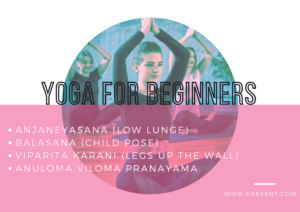
1. Anjaneyasana (low lunge):
This pose releases tension from the thighs, hips and the groin.
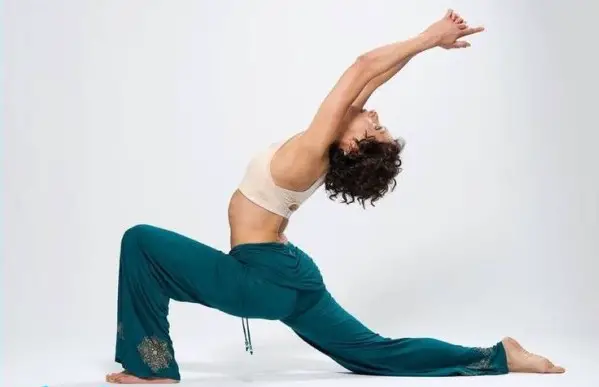
Anjaneyasana Steps:
- From the child pose, get on the knees and palms.
- Inhale; lift the right knee and place the foot forward between the palms. Align the right knee over the ankle, with the left knee on the floor. (You should feel a comfortable stretch in the left hamstring and groin. If the left knee is uncomfortable to place a cushion under it.)
- Exhale; raise the torso and place the palms on the waist to support the lower back. Maintain the extension of the spine and tuck the tail bone down towards the floor and pubic bone-in, towards the navel.
- Contract the shoulder blades in towards each other and lift the chest up.
- Hold the pose breathing deeply for 60 seconds and release by placing the palms back on the floor.
Repeat the same on the left side.
2. Balasana (child pose):
A healing pose for the body and mind, it releases tension from the spine and the hips.
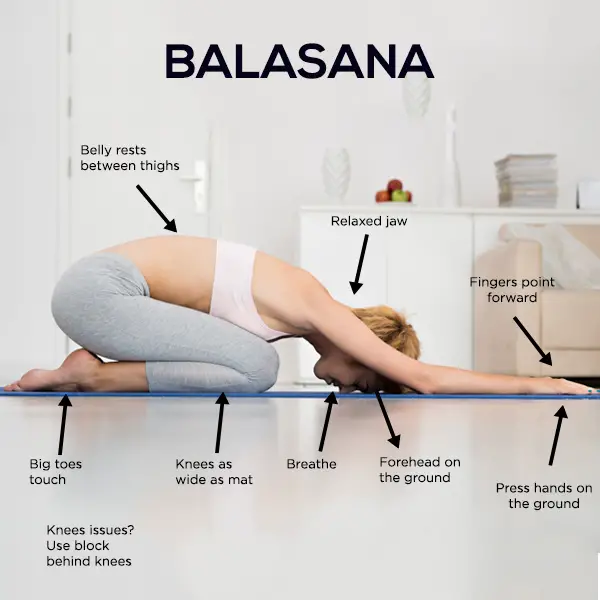
Balasana Steps:
- Get on the knees, join the big toes, thighs, and knees together.
- Place the palms on the floor and separate the knees just wide enough so the chest can rest on the thighs. (If this is not comfortable, place a bolster between the knees. If your hips don’t touch the ankle, place a blanket under the feet.)
- Inhale; raise the arms up, extending the spine.
- Exhale; come forward and rest the torso on the floor between the knees.
- Make a pillow with the palms and rest the forehead on the palms.
- Breathe deeply for one to two minutes, staying still.
- Inhale; raise the arms, and as you exhale, lower arms and release pose.
3. Viparita Karani (legs up the wall):
This pose increases circulation in the entire body releases stress and tension from the body.
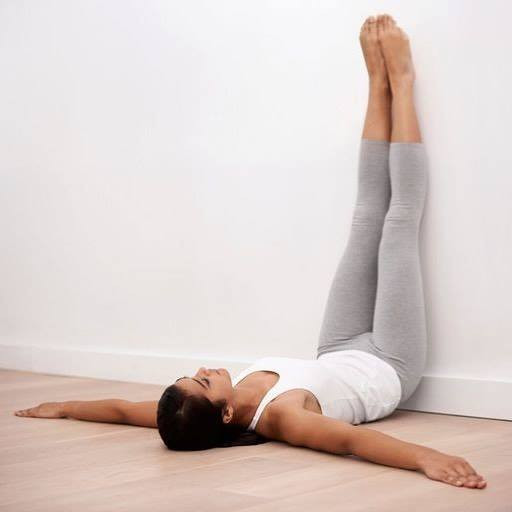
Viparita Karani Steps:
- Sit facing the wall, with the hips a few inches away.
- Lie down and raise the legs up on the wall. (Make sure that the lower back is touching the floor and if it is not, then place a bolster under the hips.)
- Keep the arms a few inches away from the body and open the palms towards the ceiling.
- Relax the entire body and stay in this pose for a few minutes.
To release the pose, bend the knees and drop them down towards the right and then sit up.
4. Anuloma Viloma pranayama:
This technique of breathing helps to balance and harmonize the functioning of the right and left hemispheres of the brain. It has a soothing effect on the nervous system and calms the mind. Because the exhalation is longer than the inhalation it encourages the removal of stale air and toxins.
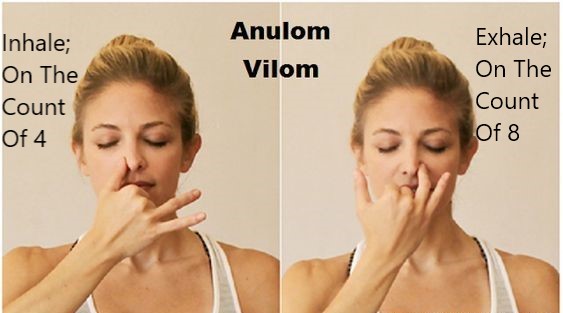
- Sit in a comfortable cross-legged position with the spine erect and the palms on the thighs.
- Raise the right hand, curling the right forefinger and middle finger into the palm, leaving the thumb, the fourth finger, and little finger extended.
- Place them on the right side of the nose and apply gentle pressure just under the bone, where the fleshy part of the nose begins.
- Inhale through the left nostril to the count of four and then exhale from the right nostril to the count of eight.
- Now Inhale from the right from the for four counts Exhale from the left for eight counts.
- Steps 4 and 5 are one round of the Pranayama.
Do 10 rounds and then rest the palms on the thighs and breathe normally.
The above yoga for beginners asanas is not meant as a substitute for medication. Please check with your doctor.
Which yoga would be best for a beginner?
Detail-oriented and slow-paced, Iyengar yoga is good for beginners. You may use props — belts, blocks, and pillow-like bolsters — to get into poses with correct alignment. Similar styles include Anusara yoga and Viniyoga.
Can beginners do yoga at home?
Yoga can be done at home, but — especially for the beginner — it is important to try a class or two that is taught by a seasoned instructor, in a private or group setting, to be sure you are doing the yoga exercises safely.
How often should a beginner do yoga?
Newbies to yoga workouts should plan to log two or three yoga sessions per week to start. This will ensure that your body gets used to the stretches and poses that you’ll be working on as you move forward in your journey.
What is the easiest yoga?
Hatha Yoga. It’s all about the basics in these slower-moving classes that require you to hold each pose for a few breaths. In many studios, Hatha classes are considered a gentler form of yoga.
Can you teach yourself yoga?
Technically you can learn yoga by yourself. However, you will spend more time and money doing so to become a skilled practitioner and run a greater risk of injury. The best approach when learning yoga on your own is to find a high-quality online course.
Who should not do yoga?
Yoga should not be performed in a state of exhaustion, illness, in a hurry, or in acute stress conditions. Women should refrain from regular yoga practice especially asanas during their menses. Relaxation techniques and pranayama can be done instead. Don’t perform yoga immediately after meals.
Is 15 minutes of yoga a day enough?
Just 15 minutes of yoga a day can rewire your brain chemistry and boost your mood. From honing flexible muscles to building mental fortitude, the benefits of yoga encompass both mind and body. … In fact, the benefits of yoga are so potent, that even a simple 15-minute daily routine is enough to totally transform your health.
Is yoga easy for beginners?
Yoga is a great form of exercise for people of all ages and fitness levels. However, beginners should look for slower-paced classes to start. With regular practice, you’ll build strength and flexibility in muscles and joints and reap mental benefits.
Does yoga hurt at first?
Many people come to yoga expecting to feel great afterward. But when you are first starting out, you’re likely to experience soreness in the hours—and possibly days—afterward. Like any exercise, holding yoga poses causes muscle contractions that result in microscopic tears to the tissue.
What is the best time to do yoga?
In general, yoga practice is recommended in the morning or the early evening. A morning yoga session can be quite active and consist of a full practice. Always finish with Savasana (Corpse Pose), no matter what time of day or season your practice. You may choose to do a different type of practice in the afternoon.
